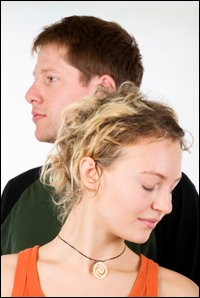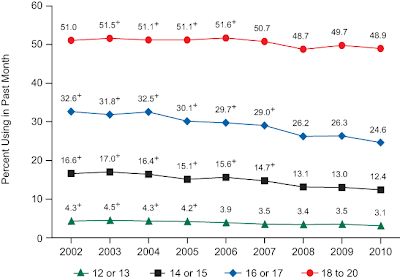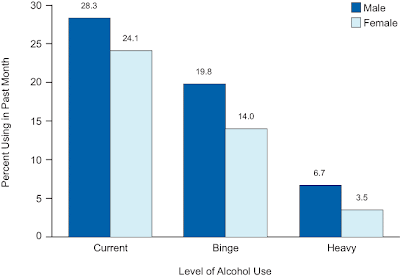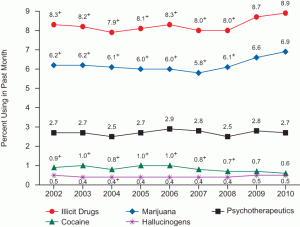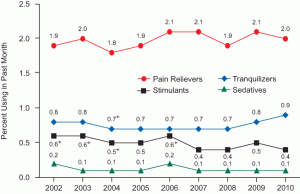2010 ALCOHOL USE in the United States
The National Survey on Drug Use and Health (NSDUH) includes questions about the recency and frequency of consumption of alcoholic beverages, such as beer, wine, whiskey, brandy, and mixed drinks. An extensive list of examples of the kinds of beverages covered is given to respondents prior to the question administration. A “drink” is defined as a can or bottle of beer, a glass of wine or a wine cooler, a shot of liquor, or a mixed drink with liquor in it. Times when the respondent only had a sip or two from a drink are not considered to be consumption. For this report, estimates for the prevalence of alcohol use are reported primarily at three levels defined for both males and females and for all ages as follows:
- Current (past month) use – At least one drink in the past 30 days.
- Binge use – Five or more drinks on the same occasion (i.e., at the same time or within a couple of hours of each other) on at least 1 day in the past 30 days.
- Heavy use – Five or more drinks on the same occasion on each of 5 or more days in the past 30 days.
These levels are not mutually exclusive categories of use; heavy use is included in estimates of binge and current use, and binge use is included in estimates of current use.
This chapter is divided into two main sections. Section 3.1 describes trends and patterns of alcohol use among the population aged 12 or older. Section 3.2 is concerned particularly with the use of alcohol by persons aged 12 to 20. These persons are under the legal drinking age in all 50 States and the District of Columbia.
3.1. Alcohol Use among Persons Aged 12 or Older
Slightly more than half of Americans aged 12 or older reported being current drinkers of alcohol in the 2010 survey (51.8 percent). This translates to an estimated 131.3 million people, which was similar to the 2009 estimate of 130.6 million people (51.9 percent).
Nearly one quarter (23.1 percent) of persons aged 12 or older participated in binge drinking at least once in the 30 days prior to the survey in 2010. This translates to about 58.6 million people. The rate in 2010 was similar to the rate in 2009 (23.7 percent).
In 2010, heavy drinking was reported by 6.7 percent of the population aged 12 or older, or 16.9 million people. This percentage was similar to the rate of heavy drinking in 2009 (6.8 percent).
Age
In 2010, rates of current alcohol use were 3.1 percent among persons aged 12 or 13, 12.4 percent of persons aged 14 or 15, 24.6 percent of 16 or 17 year olds, 48.9 percent of those aged 18 to 20, and 70.0 percent of 21 to 25 year olds (Figure 3.1). These estimates were similar to the rates reported in 2009.
Figure 3.1 Current, Binge, and Heavy Alcohol Use among Persons Aged 12 or Older, by Age: 2010

Among older age groups, the prevalence of current alcohol use decreased with increasing age, from 65.3 percent among 26 to 29 year olds to 51.6 percent among 60 to 64 year olds and 38.2 percent among people aged 65 or older.
Rates of binge alcohol use in 2010 were 1.0 percent among 12 or 13 year olds, 6.7 percent among 14 or 15 year olds, 15.3 percent among 16 or 17 year olds, 33.3 percent among persons aged 18 to 20, and peaked among those aged 21 to 25 at 45.5 percent. Binge drinking rates for 12 or 13 year olds and for 16 or 17 year olds were lower in 2010 (1.0 and 15.3 percent, respectively) than they were in 2009 (1.6 and 17.0 percent, respectively).
The rate of binge drinking in 2010 was 40.6 percent for young adults aged 18 to 25. Heavy alcohol use was reported by 13.6 percent of persons aged 18 to 25. These rates were similar to the rates in 2009 (41.7 and 13.7 percent, respectively).
The rate of binge drinking among persons aged 65 or older in 2010 was 7.6 percent, while the rate of heavy drinking was 1.6 percent in this age group. The binge drinking rate for this age group was lower than it was in 2009, when it was 9.8 percent.
The rate of current alcohol use among youths aged 12 to 17 was 13.6 percent in 2010. Youth binge and heavy drinking rates were 7.8 and 1.7 percent, respectively. These rates were all lower than those reported in 2009 (14.7, 8.8, and 2.1 percent, respectively).
Gender
In 2010, an estimated 57.4 percent of males aged 12 or older were current drinkers, higher than the rate for females (46.5 percent). However, among youths aged 12 to 17, the percentage of males who were current drinkers (13.7 percent) was similar to the rate for females (13.5 percent). The rate among males aged 12 to 17 dropped from 15.1 percent in 2009.
Among young adults aged 18 to 25, an estimated 57.0 percent of females and 65.9 percent of males reported current drinking in 2010. These rates were similar to those reported in 2009 (57.7 and 65.9 percent, respectively).
Pregnant Women
Among pregnant women aged 15 to 44, an estimated 10.8 percent reported current alcohol use, 3.7 percent reported binge drinking, and 1.0 percent reported heavy drinking. These rates were significantly lower than the rates for nonpregnant women in the same age group (54.7, 24.6, and 5.4 percent, respectively). Binge drinking during the first trimester of pregnancy was reported by 10.1 percent of pregnant women aged 15 to 44. All of these estimates by pregnancy status are based on data averaged over 2009 and 2010.
Race/Ethnicity
Among persons aged 12 or older, whites in 2010 were more likely than other racial/ethnic groups to report current use of alcohol (56.7 percent) (Figure 3.2). The rates were 45.2 percent for persons reporting two or more races, 42.8 percent for blacks, 41.8 percent for Hispanics, 38.4 percent for Asians, and 36.6 percent for American Indians or Alaska Natives.
Figure 3.2 Current, Binge, and Heavy Alcohol Use among Persons Aged 12 or Older, by Race/Ethnicity: 2010

Note: Due to low precision, estimates for Native Hawaiians or Other Pacific Islanders are not shown.
The rate of binge alcohol use was lowest among Asians (12.4 percent). Rates for other racial/ethnic groups were 19.8 percent for blacks, 21.5 percent for persons reporting two or more races, 24.0 percent for whites, 24.7 percent for American Indians or Alaska Natives, and 25.1 percent for Hispanics.
Among youths aged 12 to 17 in 2010, Asians had lower rates of current alcohol use than any other racial/ethnic group (4.8 percent), while 10.8 percent of black youths, 11.1 percent of American Indian or Alaska Native youths, 13.0 percent of youths reporting two or more races, 13.9 percent of Hispanic youths, and 14.9 percent of white youths were current drinkers. The rate for white youths was lower than it was in 2009, when it was 16.1 percent.
Education
Among adults aged 18 or older, the rate of past month alcohol use increased with increasing levels of education. Among adults with less than a high school education, 36.8 percent were current drinkers in 2010, significantly lower than the 69.1 percent of college graduates who were current drinkers.
Among adults aged 18 or older, rates of binge and heavy alcohol use varied by level of education. Among those with some college education, 27.4 percent were binge drinkers, and 8.0 percent were heavy drinkers. Among those who had graduated from college, rates of binge and heavy drinking were 23.1 and 6.6 percent, respectively.
College Students
Young adults aged 18 to 22 enrolled full time in college were more likely than their peers not enrolled full time (i.e., part-time college students and persons not currently enrolled in college) to use alcohol in the past month, binge drink, and drink heavily. Among full-time college students in 2010, 63.3 percent were current drinkers, 42.2 percent were binge drinkers, and 15.6 percent were heavy drinkers. Among those not enrolled full time in college, these rates were 52.4, 35.6, and 11.9 percent, respectively.
The pattern of higher rates of current alcohol use, binge alcohol use, and heavy alcohol use among full-time college students compared with rates for others aged 18 to 22 has remained consistent since 2002 (Figure 3.3).
Figure 3.3 Binge Alcohol Use among Adults Aged 18 to 22, by College Enrollment: 2002-2010

+ Difference between this estimate and the 2010 estimate is statistically significant at the .05 level.
Among young adults aged 18 to 22, the rate of binge drinking appears to be declining somewhat. In 2002, the binge drinking rate within this age group was 41.0 percent compared with the current 38.4 percent. Among full-time college students, the rate went from 44.4 to 42.2 percent, but the change was not significant. Among part-time college students and others not in college, the rate decreased from 38.9 to 35.6 percent during the same time period.
Employment
The rate of current alcohol use was 64.8 percent for full-time employed adults aged 18 or older in 2010, higher than the rate for unemployed adults (56.1 percent). However, the rates of binge and heavy drinking among unemployed persons (32.8 and 11.1 percent, respectively) were higher than among full-time employed persons (29.7 and 8.5 percent).
Most binge and heavy alcohol users were employed in 2010. Among 56.6 million adult binge drinkers, 42.3 million (74.7 percent) were employed either full or part time. Among 16.5 million heavy drinkers, 12.2 million (74.0 percent) were employed.
Rates of binge and heavy alcohol use did not change significantly between 2009 and 2010 for full-time employed or unemployed adults.
Geographic Area
The rate of past month alcohol use for people aged 12 or older in 2010 was lower in the South (47.5 percent) than in the Northeast (57.8 percent), Midwest (54.7 percent), or West (51.0 percent).
Among people aged 12 or older, the rate of past month alcohol use in large metropolitan areas (54.1 percent) was higher than the 50.6 percent in small metropolitan areas and 46.2 percent in nonmetropolitan areas. Binge drinking was equally prevalent in large metropolitan areas (23.5 percent), small metropolitan areas (22.8 percent), and nonmetropolitan areas (22.1 percent).
The rates of binge alcohol use among youths aged 12 to 17 were 7.8 percent in large metropolitan areas, 7.7 percent in small metropolitan areas, and 8.5 percent in nonmetropolitan areas.
Association with Illicit Drug and Tobacco Use
As was the case in prior years, the level of alcohol use was associated with illicit drug use in 2010. Among the 16.9 million heavy drinkers aged 12 or older, 31.8 percent were current illicit drug users. Persons who were not current alcohol users were less likely to have used illicit drugs in the past month (4.0 percent) than those who reported (a) current use of alcohol but no binge or heavy use (6.8 percent), (b) binge use but no heavy use (17.7 percent), or (c) heavy use of alcohol (31.8 percent).
Alcohol consumption levels also were associated with tobacco use. Among heavy alcohol users aged 12 or older, 54.5 percent smoked cigarettes in the past month, while only 17.9 percent of non-binge current drinkers and 16.1 percent of persons who did not drink alcohol in the past month were current smokers. Smokeless tobacco use and cigar use also were more prevalent among heavy drinkers (11.8 and 17.1 percent, respectively) than among non-binge drinkers (2.2 and 3.7 percent) and nondrinkers (2.0 and 2.3 percent).
Driving Under the Influence of Alcohol
In 2010, an estimated 11.4 percent of persons aged 12 or older drove under the influence of alcohol at least once in the past year (Figure 3.4). This percentage has dropped since 2002, when it was 14.2 percent. The 2010 estimate corresponds to 28.8 million persons.
Figure 3.4 Driving Under the Influence of Alcohol in the Past Year among Persons Aged 12 or Older: 2002-2010

+ Difference between this estimate and the 2010 estimate is statistically significant at the .05 level.
Driving under the influence of alcohol was associated with age in 2010. The rate was highest among persons aged 21 to 25 (23.4 percent) (Figure 3.5). An estimated 5.8 percent of 16 or 17 year olds and 15.1 percent of 18 to 20 year olds reported driving under the influence of alcohol in the past year. Beyond age 25, these rates showed a general decline with increasing age.
Figure 3.5 Driving Under the Influence of Alcohol in the Past Year among Persons Aged 16 or Older, by Age: 2010
Click on class below to begin registration:
OTHER ONLINE CLASSES at Tom Wilson Counseling Center:
ALL classes developed and monitored by Tom Wilson, a Licensed Clinical Professional Counselor who is also a Certified Alcohol and Substance Prevention Specialist. Tom is the author of “Taming Anger and Aggression“, an anger management program which has been taught to hundreds of people at the counseling center over the last twelve years. He specializes in adapting evidence-based substance abuse prevention programs for delivery through the web and other electronic media.





